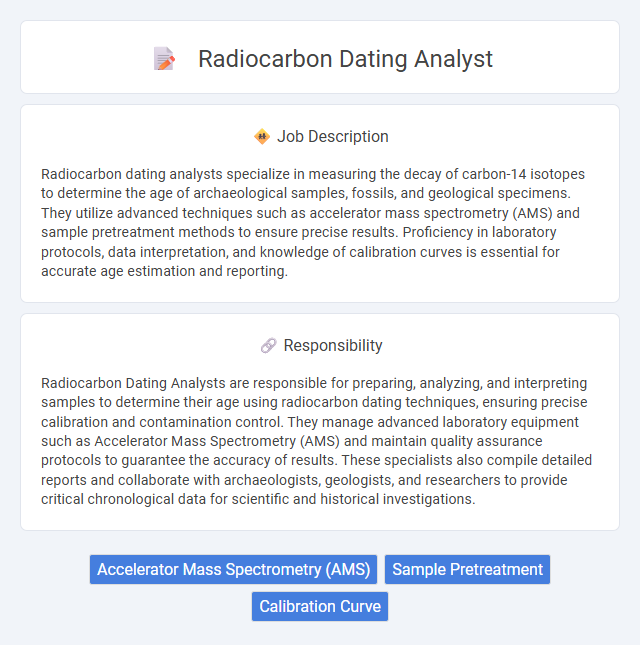
Radiocarbon dating analysts specialize in measuring the decay of carbon-14 isotopes to determine the age of archaeological samples, fossils, and geological specimens. They utilize advanced techniques such as accelerator mass spectrometry (AMS) and sample pretreatment methods to ensure precise results. Proficiency in laboratory protocols, data interpretation, and knowledge of calibration curves is essential for accurate age estimation and reporting.
Individuals with strong attention to detail and an interest in chemistry or archaeology are likely suitable for a Radiocarbon Dating Analyst position. The role may require patience and the ability to work with delicate samples, suggesting that those comfortable with meticulous lab work could perform well. Candidates who prefer hands-on scientific tasks and data interpretation might find this job fulfilling and appropriately challenging.
Qualification
A Radiocarbon Dating Analyst must possess a strong background in chemistry, geology, or archaeology, typically requiring a bachelor's or master's degree in one of these fields. Proficiency in accelerator mass spectrometry (AMS) and liquid scintillation counting techniques is essential for accurate sample analysis. Advanced knowledge of isotopic fractionation, calibration curves, and data interpretation enhances the analyst's ability to deliver precise radiocarbon age determinations.
Responsibility
Radiocarbon Dating Analysts are responsible for preparing, analyzing, and interpreting samples to determine their age using radiocarbon dating techniques, ensuring precise calibration and contamination control. They manage advanced laboratory equipment such as Accelerator Mass Spectrometry (AMS) and maintain quality assurance protocols to guarantee the accuracy of results. These specialists also compile detailed reports and collaborate with archaeologists, geologists, and researchers to provide critical chronological data for scientific and historical investigations.
Benefit
Radiocarbon dating analysts likely enjoy opportunities to work on cutting-edge scientific research that enhances understanding of historical timelines. The role probably offers access to specialized laboratory equipment and collaborative environments fostering skill development. Benefits may also include contributing to interdisciplinary projects that support archaeology, geology, and environmental studies.
Challenge
Radiocarbon Dating Analysts likely face the challenge of accurately interpreting isotopic data amidst environmental contamination and sample degradation, which may compromise dating precision. Ensuring the reliability of results could require meticulous calibration and cross-referencing with other dating methods. The complexity of distinguishing subtle variations in carbon-14 levels might demand advanced analytical skills and persistent problem-solving efforts.
Career Advancement
A Radiocarbon Dating Analyst specializes in measuring carbon isotopes to determine the age of archaeological and geological samples, utilizing advanced mass spectrometry techniques. Career advancement opportunities often include roles such as Senior Radiocarbon Specialist, Laboratory Manager, or Research Scientist, with potential growth in interdisciplinary projects combining geochemistry and archaeology. Expertise in data interpretation, laboratory management, and emerging radiocarbon technologies significantly enhances prospects for leadership positions and academic collaboration.
Key Terms
Accelerator Mass Spectrometry (AMS)
Radiocarbon Dating Analysts specializing in Accelerator Mass Spectrometry (AMS) play a crucial role in accurately determining the age of archaeological, geological, and environmental samples by measuring isotopic ratios of carbon-14. Expertise in AMS technology enables analysts to detect rare isotopes at ultra-trace levels, significantly improving precision and reducing sample size requirements compared to traditional radiometric dating methods. Advanced data interpretation skills and familiarity with contamination prevention protocols ensure reliable results that contribute to research in paleoclimatology, anthropology, and conservation science.
Sample Pretreatment
Sample pretreatment in radiocarbon dating involves removing contaminants such as carbonates, humic acids, and modern carbon to ensure accurate age determination of organic materials. Techniques like acid-base-acid (ABA) treatment and solvent extraction are critical for preparing samples before combustion or graphitization. High-quality pretreatment directly improves the precision and reliability of radiocarbon measurements used in archaeology and geosciences.
Calibration Curve
A Radiocarbon Dating Analyst specializes in interpreting radiocarbon data by applying advanced calibration curves to convert raw radiocarbon years into accurate calendar dates. Expertise in utilizing the IntCal calibration curve ensures precise alignment of radiocarbon results with historical timelines, accounting for fluctuations in atmospheric C-14 levels over time. Proficiency in software tools like OxCal and CALIB enhances the reliability of age estimations essential for archaeology, geology, and paleoclimatology research.
 kuljobs.com
kuljobs.com